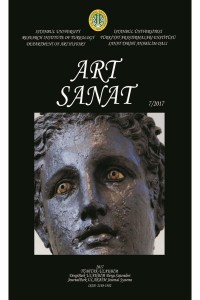Abstract
References
- Danshdoust, Yagoub. 2000. "Art of Iranian architecture in the Timurid era", Asar magazine, 1: 91-102.
- Fasih Khafi, Ahmad ibn Jalāl ad-Dīn Muhammad. 1960. Fasihi Mojmal, corrected by: Mohammad Farrukh, Volume III, Mashhad: Bastan publication.
- Golchin Arefi, Mehdi. 1999. "Khwaja Ghiyāth al-Dīn Pir Ahmad Khafi (Founder of ghyasyh school Khargerd) ", Golestan e Honar, 13: 84-89.
- Golchin Arefi, Mehdi. 2009. "Master, Qavam al-Din Shirazi, a fabulous architect", Golestan e Honar, 16: 79-85.
- Golombag, Lisa. Donald, Wilber. 1995. Timurid architecture in Iran and Turan, Keramatollah Afsar & Muhammad Yousef Kiani (trans.), Tehran: Cultural Heritage Organization. Heravi, Mail. 1970. The geography of Hafiz-i Abru, a quarter of Khorasan and Herat, Tehran: Iranian Cultural Foundation.
- O'Kane, Bernard. 2007. Timurid architecture in Khorasan, Ali Akhshini (trans.), first edition, Publisher: Islamic Research Foundation of the holy threshold of Imam Reza.
- Pakbaz, Roein. 2002. Encyclopedia of art, Tehran: Farhang e Moaser.
- Pirnia, Hassan. Abbas, Iqbal Ashtiani. Parviz Babaei. 2008. History of Iran, pre-Islam and after Islam, Pahlavi era, Tehran: Negah.
- Pope, Arthur. 1987. Iranian architecture, Gholam Hossein Sadri Afshar (trans.), first edition, Tehran: Farhangan.
- Pugachenkova, Galina. 2008. Architectural masterpieces in central Asia in the fourteenth and fifteenth centuries AD, Seyed Davoud Tabaei (trans.), Tehran: Art academy of Islamic Republic of Iran.
- Rasouli, Houshang. 2007. History and style of architecture in Iran, Tehran: Peshotanu.
- Seyed Sadr, Seyed Abu ʾl-Qasim. 2004. Encyclopedia of Art, Tehran: Simay e Danesh.
- Taghvai, Seyyed Hossein. 2012. "From style to identity in architecture", fine arts, architecture and city planning, Volume 17, 2: 65-73.
- Wilber, Donald. 2000. "Qavam al-Din Shirazi, an architect in Timurid era". Hedyeh Noorbakhsh (trans.), Golestan e Honar, 13: 74-83.
Abstract
Qavam al-Din Shirazi, famous architect of Khorasan in Timurid era, is one of the architects whose works have numerous innovations. These works had not existed before him. Dimensions, form, structure, the use of materials, creating a variety of components, intelligence in harmonization and combination of elements, are some factors that make exclusive his buildings. Irrespective of the technical characteristics of works, the use of visual effects in his buildings has a high position. The mean of visual particularities is to pay attention to visual elements and plastic fineness that Qavam al-Din is used them. The use of visual power of line, surface, different dimensions and colored harmonies that coordinate distinctive and traditional designs with the buildings framework, changed different views into distinguished art-works. The most important purpose of this study is to introduce visual particularities in an architecture style of Qavam al-Din, in addition to meet applied needs of the building, improve its architectural status. In this paper, by introducing and examining the works of Qavam al-Din, with helping existing works, images and designs that we have received from these works, we have tried to describe existing visual particularities in his works and answer correctly to the following questions:
1- What are visual particularities in the works of Qavam al-Din?
2- Did Qavam al-Din considered visual aspects these invention features?
Obtained results shows that if we examine more accurately what is created by Qavam alDin, we pay attention, should be granted which are the results of Qavam al-Din's rich genius in using visual elements. Such tempting characteristics, immediately, had a direct effect on other architectural works after him.
References
- Danshdoust, Yagoub. 2000. "Art of Iranian architecture in the Timurid era", Asar magazine, 1: 91-102.
- Fasih Khafi, Ahmad ibn Jalāl ad-Dīn Muhammad. 1960. Fasihi Mojmal, corrected by: Mohammad Farrukh, Volume III, Mashhad: Bastan publication.
- Golchin Arefi, Mehdi. 1999. "Khwaja Ghiyāth al-Dīn Pir Ahmad Khafi (Founder of ghyasyh school Khargerd) ", Golestan e Honar, 13: 84-89.
- Golchin Arefi, Mehdi. 2009. "Master, Qavam al-Din Shirazi, a fabulous architect", Golestan e Honar, 16: 79-85.
- Golombag, Lisa. Donald, Wilber. 1995. Timurid architecture in Iran and Turan, Keramatollah Afsar & Muhammad Yousef Kiani (trans.), Tehran: Cultural Heritage Organization. Heravi, Mail. 1970. The geography of Hafiz-i Abru, a quarter of Khorasan and Herat, Tehran: Iranian Cultural Foundation.
- O'Kane, Bernard. 2007. Timurid architecture in Khorasan, Ali Akhshini (trans.), first edition, Publisher: Islamic Research Foundation of the holy threshold of Imam Reza.
- Pakbaz, Roein. 2002. Encyclopedia of art, Tehran: Farhang e Moaser.
- Pirnia, Hassan. Abbas, Iqbal Ashtiani. Parviz Babaei. 2008. History of Iran, pre-Islam and after Islam, Pahlavi era, Tehran: Negah.
- Pope, Arthur. 1987. Iranian architecture, Gholam Hossein Sadri Afshar (trans.), first edition, Tehran: Farhangan.
- Pugachenkova, Galina. 2008. Architectural masterpieces in central Asia in the fourteenth and fifteenth centuries AD, Seyed Davoud Tabaei (trans.), Tehran: Art academy of Islamic Republic of Iran.
- Rasouli, Houshang. 2007. History and style of architecture in Iran, Tehran: Peshotanu.
- Seyed Sadr, Seyed Abu ʾl-Qasim. 2004. Encyclopedia of Art, Tehran: Simay e Danesh.
- Taghvai, Seyyed Hossein. 2012. "From style to identity in architecture", fine arts, architecture and city planning, Volume 17, 2: 65-73.
- Wilber, Donald. 2000. "Qavam al-Din Shirazi, an architect in Timurid era". Hedyeh Noorbakhsh (trans.), Golestan e Honar, 13: 74-83.
Details
| Primary Language | English |
|---|---|
| Journal Section | MAKALELER/ARTICLES |
| Authors | |
| Publication Date | December 30, 2017 |
| Submission Date | December 12, 2017 |
| Published in Issue | Year 2017 Issue: 7 |

